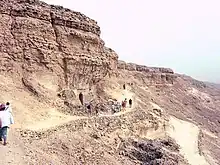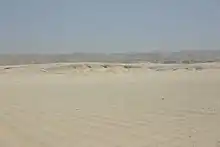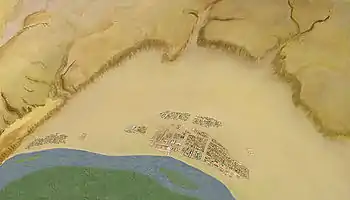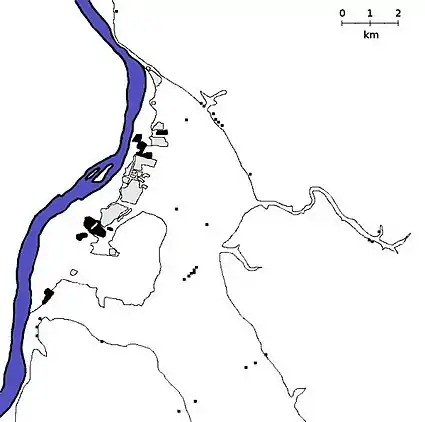Located in Middle Egypt, the Tombs of the Nobles at Amarna are the burial places of some of the powerful courtiers and persons of the city of Akhetaten.
The tombs are in two groups, cut into the cliffs and bluffs in the east of the dry bay of Akhetaten. There are 25 major tombs, many of them decorated and with their owners name, some are small and unfinished, others modest and unassuming. Each seems to reflect the personality and patronage of the tomb's original owner.
Northern tombs

These tombs are located in two groups in the cliffs overlooking the city of Akhetaten, to the north and east of the city. They are split into two groups by a wadi, and are near one of the Boundary Stelae (Stela V).
| Tomb number | Owner | Title | Comments |
|---|---|---|---|
| Amarna Tomb 1 | Huya[1] | Steward of Queen Tiye | |
| Amarna Tomb 2 | Meryre II[2] | Overseer of the houses in the royal quarters of the Great Royal Wife Neferneferuaten-Nefertiti | |
| Amarna Tomb 3 | Ahmes[1] | Sealbearer of the King of Lower Egypt, Steward in the house of Akhenaten | |
| Amarna Tomb 4 | Meryra (also called Meryre I)[2] | Greatest of seers of the Aten in Akhetaten | Incomplete. Had it been completed, it would have been the largest of the noble's tombs. |
| Amarna Tomb 5 | Penthu[1] | First servant of the Aten in the mansion of the Aten in Akhetaten, Chief of physicians, chamberlain | The tomb was cross-shaped, containing a long outer hall, and a long transverse hall, containing the burial shaft and a now destroyed shrine to Penthu. Only the outer hall is decorated. |
| Amarna Tomb 6 | Panehsy[2] | First servant of the Aten in the house of Aten in Akhetaten | This was originally a two-roomed tomb; each of the rooms had four columns. Later reuse as a Coptic church has changed the layout and damaged the original decoration. |
Desert altars
At a short distance to the west and north of the Northern Tombs lie the remains of three large mud-brick solar altars in the form of platforms with ramps. The reason for their location is not clear. Their connection with an ancient road leading to the Northern Tombs would seem to be a sign that they were for the benefit of those buried in them.
Southern tombs
The southern tombs are located in a series of low bluffs south and east of the main city. Associated with these tombs a recently discovered workers cemetery has been found.[3]

| Tomb number | Owner | Title | Comments |
|---|---|---|---|
| Amarna Tomb 7 | Parennefer[4] | Cupbearer of the king's Person | Parennefer had another tomb in Thebes, TT188 |
| Amarna Tomb 7a,b,c | Unknown[1][4] | Small unfinished tombs located near Tomb 7. | |
| Amarna Tomb 8 | Tutu[4] | Chamberlain of the Lord of the Two Lands, etc. | |
| Amarna Tomb 9 | Mahu[1] | Chief of the Medjay (police) of Akhetaten | |
| Amarna Tomb 9a,b,c | Unknown[1] | Small unfinished tombs located near Tomb 9. | |
| Amarna Tomb 10 | Ipy[1] | King's scribe, the overseer of the large inner palace of the pharaoh | |
| Amarna Tomb 11 | Ramose[1] | Scribe of Recruits, General of the Lord of the Two Lands | |
| Amarna Tomb 12 | Nakhtpaaten | Hereditary prince, count, sealbearer, overseer of the city and vizier, etc. | |
| Amarna Tomb 13 | Neferkheperuhesekheper[1] | Mayor of Akhetaten | |
| Amarna Tomb 14 | May[4] | General of the Lord of the Two Lands, etc. | |
| Amarna Tomb 15 | Suti[1] | Standard-bearer of the company of Neferkheprure-Waenre (Akhenaten) | |
| Amarna Tomb 16 | unknown | ||
| Amarna Tomb 17 | unknown | ||
| Amarna Tomb 18 | unknown[4] | Only the facade of the tomb was completed | |
| Amarna Tomb 19 | Satau[4] | Treasurer of the Lord of the Two Lands | |
| Amarna Tomb 20 | unknown[4] | The lintel shows the royal family adoring the Aten | |
| Amarna Tomb 21 | unknown[4] | ||
| Amarna Tomb 22 | unknown[4] | The lintel shows the royal family adoring the Aten | |
| Amarna Tomb 23 | Any[4] | Scribe of the offering table of the Lord of the Two Lands, Steward of the House of Aakheprure (Amenhotep II), etc. | |
| Amarna Tomb 24 | Paatenemheb[4] | General of the Lord of the Two Lands, Steward of the Lord of the Two Lands | |
| Amarna Tomb 25 | Ay[4] | Fanbearer on the right of the King, God's Father, The commander of all the horses of his Person | Ay was a future pharaoh of Ancient Egypt |
| Southern Tomb 25a[4] | Ia (?) |
Rediscovery and excavation
Some of the tombs have obviously been open since antiquity, and have been used variously as burial places in the Ptolemaic times, storehouses, houses and as Coptic churches.
See also
Notes and references
References
- 1 2 3 4 5 6 7 8 9 10 N. de G. Davies, The rock tombs of El-Amarna, Parts III and IV, 1905 (Reprinted 2004), The Egypt Exploration Society, ISBN 0856981605. Facsimile in Internet Archive: Part III. The Tombs of Huya and Ahmes, 1905 and Part IV. The Tombs of Penthu, Mahu and Others, 1906
- 1 2 3 N. de G. Davies, The rock tombs of El-Amarna, Parts I and II, 1905 (Reprinted 2004), The Egypt Exploration Society, ISBN 0856981591. Facsimile in Internet Archive: Part I. The Tomb of Meryre, 1903 and Part II. The Tombs of Panehesy and Meryra II, 1905
- ↑ "The Pharaoh's Lost City". Retrieved 2008-01-29.
- 1 2 3 4 5 6 7 8 9 10 11 12 13 N. de G. Davies, The rock tombs of El-Amarna, Parts V and VI, 1905 (Reprinted 2004), The Egypt Exploration Society, ISBN 0856981613. Facsimile in Internet Archive: Part V. Smaller Tombs and Boundary Stelae, 1908 and Part VI. Tombs of Parennefer, Tutu and Ay, 1908
Further reading
- N. de G. Davis – The Rock Cut Tombs of El Amarna. Society for the Study of Egyptian Antiquities, 2004 (ISBN 0856981605). Facsimils in Internet Archive: Part I. The Tomb of Meryre, 1903; Part II. The Tombs of Panehesy and Meryra II, 1905; Part III. The Tombs of Huya and Ahmes, 1905; Part IV. The Tombs of Penthu, Mahu and Others, 1906; Part V. Smaller Tombs and Boundary Stelae, 1908 y Part VI. Tombs of Parennefer, Tutu and Ay, 1908.
- Owen, Gwil – The Amarna courtiers' tombs. Egyptian Archaeology Autumn 2000


.jpg.webp)